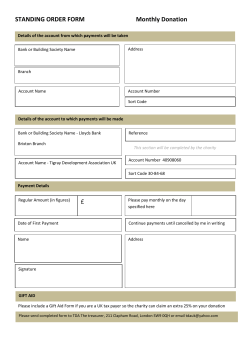
International Flow of Funds
Chapter 2 International Flow of Funds (Balance of Payments) J. Gaspar: Adapted from Jeff Madura International Financial Management 2- 1 Balance of Payments (BOP) The balance of payments is a statement of accounts that summarizes all transactions between residents of one country and the rest of the world, for a specific period of time, normally a year. Inflows of funds generate credits (+) for the country’s BOP, while outflows of funds generate debits (-). 2- 2 Chapter Objectives To explain the key components of the balance of payments; To explain the significance of each line item of BOP; and To explain how the international flow of funds is influenced by economic and geopolitical factors. 2- 3 The Current Account Balance The current account summarizes the flow of funds between a country and rest of the world due to purchases of goods, services, and income from financial assets and transfer payments. The current account balance measures a country’s savings surplus or deficit and indicates the financing needs of a country. Countries that incur a current account deficit will witness a downward pressure on their currency to depreciate. 2- 4 United States: Balance of Payments ‐ Standard Components US Dollars, Millions Data reported to the IMF on a BPM6 basis. Metadata CURRENT ACCOUNT Goods & Services (merchandise and services balance) Total Credit Total Debit Goods (merchandise trade balance) Credit (merchandise exports) Debit (merchandise imports) Services (services balance) Credit (service exports) Debit (service imports) Income Balance (net primary income) Net Transfers (net secondary income) CAPITAL ACCOUNT FINANCIAL ACCOUNT Net Foreign Direct Investments Net Portfolio Investments Net Financial Derivatives Other Short‐Term Investments (primarily trade finance and hot money) Change in Reserve Assets (primarily change in international reserves) NET ERRORS AND OMISSIONS 2009 −380,793.00 −383,778.00 1,583,051.00 1,966,829.00 −509,696.00 1,070,330.00 1,580,026.00 125,918.00 512,721.00 386,803.00 123,587.00 −120,602.00 −141.00 −230,942.86 159,938.00 18,530.00 −44,816.00 −416,777.39 52,182.53 149,991.14 2010 −443,932.00 −494,659.00 1,853,604.00 2,348,263.00 −648,678.00 1,290,274.00 1,938,952.00 154,019.00 563,330.00 409,311.00 177,660.00 −126,933.00 −158.00 −436,983.95 95,231.00 −620,815.00 −14,076.00 100,851.00 1,825.05 7,106.05 2011 −459,348.00 −548,629.00 2,127,019.00 2,675,648.00 −740,644.00 1,499,240.00 2,239,884.00 192,015.00 627,779.00 435,764.00 220,960.00 −131,679.00 −1,186.00 −515,653.25 182,996.00 −226,263.00 −35,006.00 −453,363.00 15,982.75 −55,119.25 2012 −460,742.00 −537,598.00 2,216,543.00 2,754,141.00 −742,093.00 1,561,691.00 2,303,784.00 204,495.00 654,852.00 450,357.00 202,992.00 −126,136.00 6,904.00 −423,483.61 157,759.00 −507,221.00 7,064.00 −85,550.00 4,464.39 30,354.39 2013 −400,253.00 −476,391.00 2,280,197.00 2,756,588.00 −701,667.00 1,592,786.00 2,294,453.00 225,276.00 687,411.00 462,135.00 199,653.00 −123,515.00 −413.00 −370,639.78 113,274.00 −1,067.00 2,248.00 −482,010.00 −3,084.78 30,026.22 2014 −410,634.00 −504,715.00 2,344,525.00 2,849,240.00 −735,788.00 1,635,133.00 2,370,921.00 231,073.00 709,392.00 478,319.00 217,902.00 −123,821.00 ... −141,646.47 260,109.00 −145,140.00 −53,531.00 −199,501.00 −3,583.47 269,032.53 This data report uses the BOP Standard Presentation format as defined in the 6th Edition of the Balance of Payments Manual (BPM6). (‐) Indicates that a figure is zero (...) Indicates a lack of statistical data that can be reported or calculated from underlying observations Data Source: Balance of Payments Statistics (BOP) Data extracted from IMF Data Warehouse on: 5/6/2015 5:08:23 PM 2- 5 Financial Account Balance • The financial account summarizes the flow of funds resulting from the sale/purchase of assets between one country and rest of the world. • The key components of the financial account are foreign direct investment, portfolio investment, trade finance and other short-term capital investment, so called “hot” money. 2- 6 International Trade Flows Some countries are more dependent on trade than others. The trade volume of a European country is typically between 30 – 40% of its GDP, while the trade volume of U.S. (and Japan) is typically between 10 – 20% of its GDP. Nevertheless, the volume of trade has grown over time for most countries. 2- 7 2- 8 2- 9 Trade Agreements Many agreements have been made to reduce trade restrictions: 1948 General Agreement on Tariffs and Trade (GATT) 1992 Single European Act and the European Union 1988 U.S. and Canada free trade pact 1994 North American Free Trade Agreement (NAFTA) 2004 CAFTA-DR 2007 ASEAN Free Trade Area 2-10 Trade Disagreements However, even without tariffs and quotas, governments seem always able to find strategies that can give their local firms an edge in exporting: different environmental, labor laws bribes, government subsidies (dumping) tax breaks for specific industries exchange rate manipulations 2- 11 Trade Disagreements Other trade-related issues include: the outsourcing of services the use of trade policies for political reasons (e.g., Cuba, Iran, Russia, etc.) disagreements within the European Union Trans Pacific Partnership (TPP) and disagreements with China 2- 12 Factors Affecting International Trade Flows • Impact of Inflation • A relative increase in a country’s inflation rate will worsen its current account, as imports increase and exports decrease. • Impact of National Income • A relative increase in a country’s income level will worsen its current account, as imports increase. 2-13 Factors Affecting International Trade Flows • Impact of Government Restrictions • A government may reduce its country’s imports by imposing a tariff on imported goods, or by enforcing a quota. • Some trade restrictions may be imposed on certain products for health and safety reasons. 2-14 Factors Affecting International Trade Flows • Impact of Exchange Rates • If a country’s currency begins to rise in value, its current account balance will worsen as imports increase and exports decrease. The factors interact, such that their simultaneous influence on the balance of trade is complex. 2- 15 Correcting A Balance of Trade Deficit • By reconsidering the factors that affect the balance of trade, some common correction methods can be developed. • A floating exchange rate system may correct a trade imbalance automatically since the trade imbalance will affect the demand and supply of the currencies involved. 2- 16 Why a Weak Home Currency Is Not a Perfect Solution • Counter pricing by competitors • Impact of other weak currencies • Stability of intracompany trade • Many firms purchase products that are produced by their subsidiaries. • Prearranged international transactions • The lag time between a weaker U.S.$ and increased foreign demand has been estimated to be 18 months or longer. 2- 17 U.S. Trade Balance The J-Curve Effect Time 0 J Curve Deterioration due to dollar depreciation Change in purchasing power caused by weaker dollar 2- 18 Factors Affecting DFI • Changes in Restrictions • New opportunities may arise from the removal of government barriers (deregulation). • Privatization • DFI is stimulated by the selling of public assets (government/state enterprises). • Potential Economic Growth • Countries that have higher potential for economic growth are more attractive. 2- 19 Factors Affecting DFI • Tax Rates • Countries that impose relatively low tax rates on corporate earnings are more likely to attract DFI. • Exchange Rates • Firms typically prefer to invest in countries where the local currency is expected to strengthen against their own. 2- 20 Factors Affecting International Portfolio Investment • Tax Rates on Interest or Dividends • Investors normally prefer countries where the tax rates are relatively low. • Interest Rates • “Hot Money” tends to flow to countries with high interest rates. • Exchange Rates • Inflow of foreign investment increases when the domestic currency is expected to strengthen. 2- 21 Agencies that Facilitate International Flows • International Monetary Fund (IMF) • The IMF encourages internationalization of businesses through BOP support, stabilizing exchange rate movements, and financial and technical assistance. • Its compensatory financing facility attempts to reduce the impact of export instability on country economies. • The IM F adopts a quota system, and its financing is measured in special drawing rights (SDRs). 2- 22 Agencies that Facilitate International Flows • World Bank • The International Bank for Reconstruction and Development (IBRD) provides market-based loans to countries seek to enhance their economic development. • In particular, its Structural Adjustment Loans (SALs) are intended to enhance a country’s long-term economic growth/competitiveness. • Funds are increased through co-financing agreements with official aid agencies, export credit agencies, and commercial banks. 2- 23 Agencies that Facilitate International Flows • Multilateral Investment Guarantee Agency • An agency of the World Bank Group, the MIGA helps develop international trade and investment by offering various forms of political risk insurance. • International Development Association • The IDA extends loans at low interest rates to poor nations that cannot afford market-based loans from the World Bank. 2- 24 Agencies that Facilitate International Flows • World Trade Organization • The WTO was established to provide a forum for multilateral trade liberalization and to settle trade disputes between member nations. • International Financial Corporation • The IFC promotes private enterprise and capital markets in developing countries through loan provisions and stock purchases. 2- 25 Agencies that Facilitate International Flows • Bank for International Settlements • The BIS is the “central banks’ central bank” and “lender of last resort” that sets capital adequacy guidelines for global banks • Regional development agencies • Inter-American Development Bank • Asian Development Bank • African Development Bank • European Bank for Reconstruction and Development. • Asian Infrastructure Investment Bank (AIIB) 2-26
© Copyright 2025








